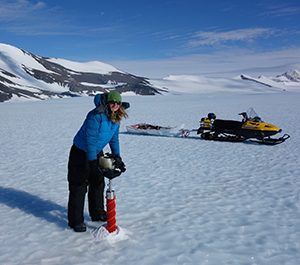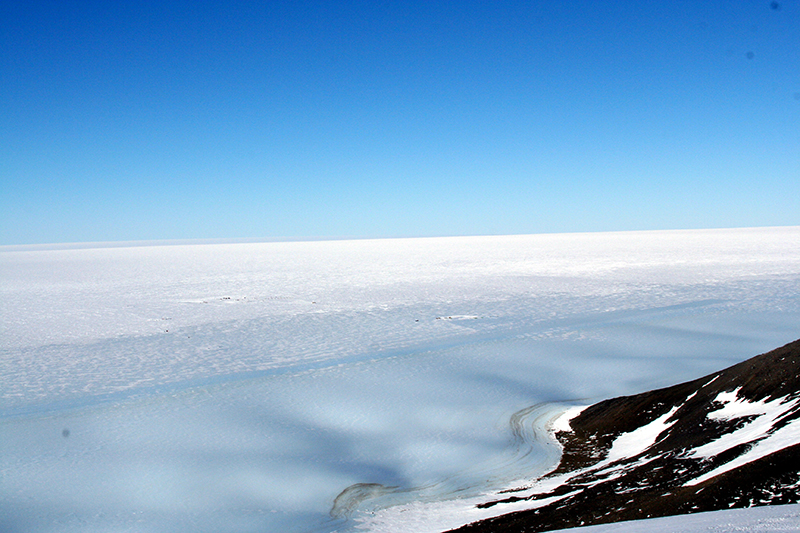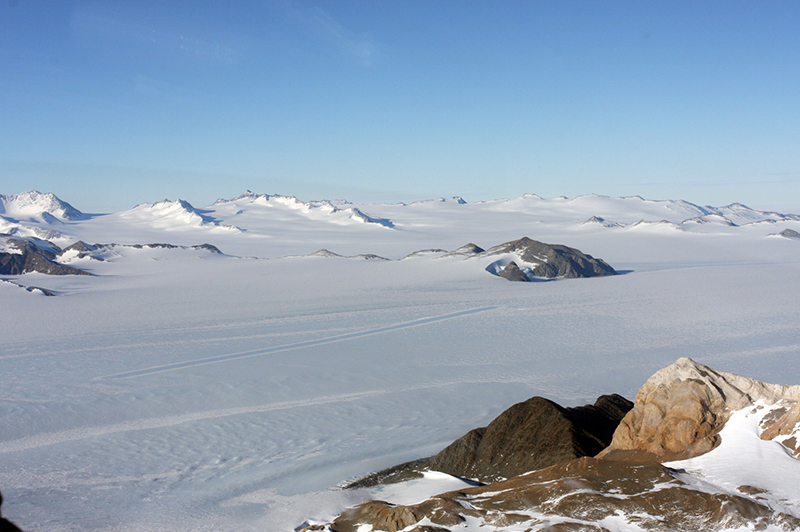ALE uses blue-ice airfields to land wheeled aircraft in Antarctica. These snow-free areas are a cornerstone of our operations. But what are blue-ice fields? How are they formed? And what makes them so special?
What are blue-ice fields? How are they formed?
 Blue-ice fields are glacial areas that remain snow-free. Most of the Antarctic ice sheet is covered by snow, since the accumulation of snow by precipitation, wind deposition and condensation exceeds ablation (loss) by evaporation and wind erosion. In blue-ice areas the ice is on the surface with no blanket of snow, because wind and evaporation remove more snow than is accumulated. These relatively small net ablation areas are scattered over the continent.
Blue-ice fields are glacial areas that remain snow-free. Most of the Antarctic ice sheet is covered by snow, since the accumulation of snow by precipitation, wind deposition and condensation exceeds ablation (loss) by evaporation and wind erosion. In blue-ice areas the ice is on the surface with no blanket of snow, because wind and evaporation remove more snow than is accumulated. These relatively small net ablation areas are scattered over the continent.
Blue-ice areas in the Antarctic interior typically form where mountains disturb the flow of katabatic winds. Blowing snow is deposited on the upwind side of the mountains, with a turbulent wake of snow-free air on the downwind side. The gusty winds on the lee side of the mountains strip away any snow that might fall during calm weather and the ice itself erodes by evaporation. Over time a very thick layer of ice can be removed by ablation, revealing older layers that were once deeply buried and bringing embedded solids to the surface.
Why is blue-ice blue?
The cold, dry Antarctic snow has a high albedo (reflectance). Almost all of the visible light that strikes the snow is reflected back without any preference for a single color, causing the snowfields to appear bright white in natural daylight. Blue-ice has a lower albedo, making the surface look relatively dark. In addition, the ice acts like a filter absorbing red and yellow and reflecting blue light, so that the ice appears blue.
 Implications for science
Implications for science
The formation of blue-ice areas has two interesting outcomes for scientists. On a blue-ice area where ablation is greatest close to the mountains, you can essentially walk backwards in time over older and older layers of ice as you walk toward the mountains. Scientists can obtain long records by taking ‘horizontal ice cores’ as opposed to vertical ones. Antarctic blue-ice is also the premier hunting ground for meteorites for scientific study. Meteorites that have fallen in upstream accumulation zones over millennia are ‘given up’ when they reach an ablation area, since the ice evaporates and they are left behind on the surface. Over tens of thousands of years phenomenal concentrations of meteorites can develop. The US Antarctic Search for Meteorites (ANSMET), and Korean Antarctic Meteorite Program (KOREAMET) are multi-year meteorite studies that search for meteorites on blue-ice. More about blue-ice coring
Blue-ice airfields
The cold, dry snow that covers most of Antarctica is only suitable for landing ski aircraft, which do not typically have the range to operate intercontinental flights. In contrast, blue-ice has sufficient bearing capacity to support wheeled transport aircraft carrying heavy loads. Blue-ice areas were investigated over the years with the idea that they could perhaps be used as airfields where wheeled aircraft could land – a concept with the potential to radically change Antarctic operations.
Most Antarctic bases are located on the coast, where they are re-supplied by ship. Access is limited to a short period during the summer when the sea-ice breaks out. Stations in the interior are typically re-supplied by overland tractor-traverse from the coast. Wheeled aircraft would allow direct access to the interior of Antarctica and would enable access to coastal stations in November and December, when sea-ice prevents re-supply by ship.
The idea of using blue-ice ablation areas as airfields probably originated during Operation Deepfreeze (1955-60). The US Army Corps of Engineers studied blue-ice airfields in the early 1970’s, with the idea of flying large conventional aircraft from New Zealand or South America to inland areas of Antarctica. Several promising sites were identified and surveyed, but not developed at the time. Adventure Network International picked up the concept and contracted glaciologist Dr. Charles Swithinbank to reconnoitre potential blue-ice airfields in the Ellsworth Mountains. A suitable site was found and surveyed at Patriot Hills. ANI began operation of the first inland, blue-ice runway in November 1987 using a DC-4.
Government operators from several countries have since developed runways for landing wheeled aircraft e.g. Italy at Terra Nova Bay station (sea-ice runway and blue-ice runway), Australia at Law Dome, near Casey station (blue-ice runway), Norway at Troll Station (blue-ice runway), Russian Federation at Novolazarevskaya (blue-ice runway), USA at Williams Field (compressed snow runway).

Patriot Hills Blue-Ice Runway
ANI operated successfully for over 20 seasons at the Patriot Hills site. The DC-4 was used from 1987 to 1989 when it was replaced by a DC-6 which, in turn, was replaced by a Lockheed Hercules L-382 in 1993. By 2000 ANI was using the larger capacity Ilyushin 76 TD for intercontinental flights from Punta Arenas Chile to Antarctica. In 2003 ALE purchased ANI and continued air operations to Patriot Hills blue-ice runway.
In 1995 FACh (Chilean Air Force) landed on SCPZ Runway 24M with a Hercules C-130. Subsequent flights were undertaken to prepare for the installation of a Summer Station at Patriot Hills. Base Teniente Parodi was inaugurated on December 6 1999, becoming Chile’s furthest south station. Parodi was used to support scientific research and training for twin otter pilots, as well as for SAR support for expeditions in the region and to the South Pole.

Union Glacier Blue-Ice Runway
After much research Antarctic Logistics and Expeditions (ALE), identified Union Glacier as a potential landing site in 2006. Two seasons of weather data was gathered and detailed surveys carried out. Proving flights were successfully undertaken by the Ilyushin in December 2009 and January 2010 and our first passenger flight from Punta Arenas, Chile to SCGC took place mid-November 2010. SCGC is an into-wind runway which allows us to offer a more predictable flight schedule with less likelihood of delays to our programs, as well as enhanced logistic support in Antarctica. Patriot Hills remains as our secondary runway in Antarctica.
The distance between the blue-ice runway and our main camp is approximately 5 ½ miles (9km). A small passenger terminal is located next to the runway. It is used by passengers waiting to board the aircraft and as a shelter in case of inclement weather, for staff working at the runway. Specially-adapted 4×4 passenger vans and tracked vehicles are used to transport guests from the runway to camp.
Certification & Environmental Care
The blue-ice runways operated by Antarctic Logistics and Expeditions have been certified by the Dirección General de Aeronáutica Civil de Chile (DGAC) and are part of the Chilean Airports and Aerodromes System. The international codes for these blue-ice runways are SCPZ Runway 24M (Patriot Hills) and SCGC Runway 18M (Union Glacier).
ALE’s runway facilities are completely self-contained to prevent any spillage or loss onto the blue-ice area of any waste, fuels, oils, grey or black water. A double walled fuel tank with integral shut off valves is sited at the runway for fuelling vehicles needed for runway activities.
Further Reading
- Mellor and Swithinbank, 1989. Airfields on Antarctic Glacier Ice. CRREL Report 89–21
- Mellor, 1993. Notes on Antarctic Aviation. CRREL Report 93-14 http://www.crrel.usace.army.mil/library/crrelreports/CR93_14.pdf (Note: 13Mb file and may be slow to download)